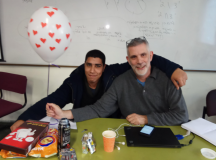The Basic Skills Training Group, or simply ‘T-group’, was popularised in the 1950s as a humanistic therapeutic approach – intimate, interpersonal, emotional, confessional – to help individuals overcome patterns of maladaptive behaviour. Channa Newman and Thomas Mullane argue that the deployment of T-group techniques in the university classroom has enabled ‘a partisan agenda that engulfs students in righteous indignation, indulges them in conspiratorial thinking, strips them of moral autonomy, and forges them into a legion of social justice warriors dedicated to eliminating the imaginary threat of Zionism’.
In ‘Poisonous Pedagogy: Israel Hatred and the Collapse of Liberal Education’ (Fathom, September 2019), William Kolbrener calls attention to a current mode of interaction between professors and students and its contribution to the rise of antisemitism on American campuses. The toxic pedagogy is said to involve ‘woke’ professors who deposit a simplistic narrative of good versus evil in the passive minds of ‘millennials.’ Objectionable as this approach to university teaching may be, another pedagogical model based on the technique of the T-group, where emotions not minds are typically engaged, should also be considered. This technique, we argue here, plays a significant role in undermining liberal education in general and in mobilising the ‘assent’ of millennials to Israel hatred in particular. Unlike the lecture, the T-group converts the liberal arts classroom into an intimate environment of fifteen or fewer students, where the interpretive focus is on the emotionally-laden ‘here-and-now’ experiences of each student. Objectivity and reasoned debate along with even-handed consideration of history and social context are by virtue of the small group pedagogy prescriptively ‘cancelled’.
Origins
The origins of the T-group can be traced to a multi-dimensional study conducted in 1946 by social theorist Kurt Lewin that sought to identify practical methods for improving ethnic relations in the state of Connecticut. Included in this research were ‘feedback sessions’ in which psychological investigators and community leaders would meet informally to discuss differences in observation and understanding of events. Following Lewin’s death in 1947, the idea of the feedback session was developed into a template for the Basic Skills Training Group, or simply ‘T’ group, a face-to-face and casual environment in which personal disclosures and interpersonal relationships take center stage.
Popularised in the 1950s as a humanistic approach for helping individuals to overcome patterns of maladaptive behavior, the T-group has proven a versatile tool of social control. It can serve either to question cognitive bias or to confirm it. Transparency and disclosure of group aims was the general practice in the humanistically-oriented sensitivity training and encounter groups of the 50s, 60s, and 70s, where ‘consciousness raising’ and ‘self-actualisation’ were the ultimate goals. The same can be said for the trauma-recovery and self-help groups that have been standard features of mental health treatment in the US since the 1980s. In all these situations leaders were expected to act in accordance with democratic ideals. However, when the group setting is managed in an authoritarian, manipulative, and non-transparent manner, the less welcome effects of T-groups – such as reinforcing social prejudice, triggering psychiatric symptoms, and nurturing inappropriate and cult-like relationships – are potentially more likely to occur.1
Despite the risks for psychological harm, the T-group model of classroom management2 – marketed as ‘experiential learning’ – was broadly introduced into the field of liberal education in the 1970s. For the ‘progressive Left’ and the campaign of identity politics, the interpersonal format has provided the psycho-social infrastructure needed to mobilise and maintain ideological communities that would otherwise be unlikely to form and reproduce themselves. For the BDS movement specifically the methodology has been highly effective in guiding vulnerable American undergraduates – obviously without their informed consent – from the not uncommon baseline condition of prejudice characterised as ‘epistemic antisemitism’ to the near delusional state of righteous indignation and heightened impulsivity denoted as ‘Israel Derangement Syndrome.’
The T-Group and BDS Pedagogy
The issue of pedagogy is essential to the BDS movement for the simple reason that the moral certainty it aims to arouse is based not on rational and impersonal principles – the traditional ground of authority in institutions of higher learning in democratic societies – but on emotional factors and personal values that must be strategically aroused and channeled into action. An example of the primacy of emotion over reason in BDS pedagogy is expressed by an activist professor from the University of Mary Washington in Virginia who explained to peers at the Middle East Studies Association’s annual meeting in 2020 how best to teach the ‘BDS controversy’: ‘I am open about my own views; at the start, for example, I inform students that, despite initial misgivings, I support BDS, but I do not share the reasons why.’3 The emphasis in activist pedagogy is not on transmission of knowledge and facts but on students’ affective experiences. Events are presented as episodes of extreme violence and discussed as traumas; dispassionate analysis of the socio-historical context is replaced by exercises in empathy. Under the leadership of a BDS advocate, the T-group classroom functions as a de facto personality market where students who are most willing to declare feelings of moral outrage and who believe most fanatically that they are genuine agents of progressive social change are identified and connected to organisations dedicated manifestly to ‘criticism’ of Israel and latently to its elimination.
In the theatre of the T-group classroom it is chiefly through the leader’s performance of what David Hirsh has dubbed the “Livingstone Formulation” that students are recruited to the ideology of BDS. The leader is a role model, a moral example. Fortified by their close personal relationship with the leader, receptive students acquire confidence to believe in absolute terms – without having to know the reasons why – that they are on the side of virtue and that those who charge that criticism of Israel can be antisemitic are themselves enemies of academic freedom and enablers of the racist creed of Zionism.
Also prominent in the professorial discourse of the BDS advocate is the rhetorical device of apophasis. A favourite of the New Deal era agitator and antisemitic social justice warrior Charles (‘Father’) Coughlin, this sleight-of-hand, which allows the killing of two birds with one stone while pretending just to be watching birds, is a shrewd way to equate Israelis with Nazis without being perceived as making the equation in the first place. The following illustration of what amounts to Holocaust inversion is taken from a pre-departure workshop for American Fulbright scholars selected in 2014 to study in Jordan.4 Though seemingly leading in a different direction, the bullet in the end hits the intended target, in this case the identification of Israelis with Nazis:
. . . One correction that I always have to make to students, and I don’t know if there is a single ‘aha’ moment … but as we move along there’s always a student or two who says, ‘Well, the Israelis are just like the Nazis. This is just like the Holocaust,’ and I have to correct them . . . there’s a difference between genocide and ethnic cleansing. . . I definitely . . . think there is danger in exclusively looking at the Holocaust and . . . propping the Holocaust up on a pedestal and ignoring every other human tragedy but like every time someone wants to find something bad they compare it to Hitler, Nazism and the Holocaust . . . the ethnic cleansing of Palestine can be seen as a tragedy, as a catastrophe as the Palestinians put it without equating it to the Holocaust . . . So that’s a response I often get from students, ‘Oh, it’s the same thing.’ And there are similarities, so maybe for the brightest students you can tease out some of these similarities . . .
Three Stages of Ideological Indoctrination
Along with the deceptive rhetoric, the archetypal anti-Zionist T-group classroom follows a three-step sequence characteristic of ideological indoctrination across cultures.
- In the first step of this blueprint, a ‘teacher’ introduces a stimulus to a ‘learner’ which elicits an emotional response, positive or negative, that prompts the learner to reaffirm, call into question or reconsider previous attitudes and beliefs.
- In the second step, the artifice of ritual is used to establish bonds of identification between the teacher – who embodies the ideology to be imposed – and the learner.
- The third step includes a trial or test that requires the learner to enact publicly the moral imperative of the either newly-acquired or reinforced ideology.
Step 1: Arouse emotion and moral outrage
In the case of anti-Zionist indoctrination, the emotion aroused in the initial step is moral outrage. The ‘woke’ professor, acting as editor and cue-giver, aggressively stimulates this experience by providing students with course assignments that consist of news reports and opinion pieces from partisan publications, videos, photographs, maps, and social media posts that highlight blood and death and alleged human rights violations committed by Israel. A complex social history is thereby reduced to isolated incidents of trauma that are interpreted with the aid of shock-value terms – e.g. apartheid, ethnocide, genocide, colonialism, racism, catastrophe, and even crucifixion – that serve the sole purpose of demonising Israel.
Step 2: Encourage collective moral condemnation
In the second step of anti-Zionist indoctrination the moral outrage generated against Israel is diverted into a healing rite of public confession in which all students are obligated to articulate before professor and peers their reactions to the incendiary and biased course content. The role of the professor is twofold: first to reassure students who are being put on the ‘hot seat’ that the classroom is a safe space and second to instill in students the belief that moral condemnation of Israel is noble and just. The ritual predictably unfolds as a succession of testimonials bearing witness to ‘what I saw,’ ‘what I heard,’ ‘what I read,’ and ‘what I felt’ which culminate in a bandwagon effect of Israel hatred and a group chorus of ‘what can be done?’
Feigning reluctant willingness to ‘answer the call’ on behalf of students, the BDS organiser exploits the consensus against Zionism that has formed as a consequence of the biased course design. Students, who have been offered a safe space to voice feelings of being overwhelmed and angry, are at this point gently introduced to additional resources and social media sites that claim to support a human rights agenda addressing injustice and aiming to alleviate suffering. For some students, the ritual replaces feelings of being alone and anonymous with a new-found sense of being bonded to important others who share the same higher purpose. The effect of the group confession may thus be experienced as therapeutic. Unlike students with less need for external validation, these students are likely to succumb willingly to the grandiose illusion that they have discovered the ‘evil’ of Zionism on their own and that in giving it their ‘assent’ before others they have acted as free and conscious decision-makers rather than as recruits who have been moulded and trained for a specific outcome. The most vocal, vulnerable, and narcissistically-injured of this group are poised to proclaim their nascent social identity and to resist and cancel anyone who would dare question the integrity of the movement to save Palestine. Predisposed to authoritarian and conspiratorial thinking that pits good against evil, they are ready to insist that if one is pro-Palestinian one must be anti-Israeli and vice-versa.
In addition to the peer pressure that is amplified in the T-group classroom, students in general have practical reasons for submitting to the group consensus, such as knowing that in a competitive job market getting top grades is an advantage and if this means affirming or parroting the moral perspective of a professor, then so be it. When this is the primary motivation and rationale for the student, the end result of anti-Zionist indoctrination is likely not anti-Israel fanaticism but rather confirmation and reinforcement of a pre-existent and culturally-acquired bias against Jews.
It is important to note as well that in the T-group confessionals the BDS advocate manipulates students not only by assuming a false pose of rationality and impartiality, but more insidiously by constraining the level and quality of the group’s moral reasoning. The undisclosed aim in this regard is to ensure that students with little understanding of the socio-historical context are also blind and indifferent as to the intentions of the actors involved. For this reason the group focus is kept exclusively on the severity of the crimes attributed to Israelis and on each student’s personal experience of ‘what it must have been like’ for the Palestinian victims.
Step 3: Issue a call to action
The degree to which the ideology of anti-Zionism has been internalised is put to the test in the concluding step of the indoctrination process with a call to action that seeks to solidify passion against the identified scapegoat. Under intense pressure to conform in the T-group setting, students are given the choice of doing something or nothing about the injustice they have witnessed via the course materials. Acting at this stage as BDS liaison, the anti-Zionist professor links students who have demonstrated sufficient enthusiasm to a host of external organisations – e.g. Students for Justice in Palestine, the United States Campaign for the Cultural and Academic Boycott of Israel, Friends of Sabeel North America, and the Israel-Palestine Missionary Network – that share the same political objective. For the BDS movement, all the steps outlined above are implemented in the format of the T-group and work together on American campuses to provide a valuable yield: a youthful cadre of righteously enraged foot soldiers who are are ready to do whatever they can, by whatever means necessary, to take the fight against Israel to the wider public.
Conclusion
The history of the 20th century provides clear examples of how knowledge of group dynamics can be manipulated to serve the cause of ethnic hatred and war. Yet the 21st century deployment of the T-group model throughout the domain of liberal education has somehow gone unnoticed. Disguised as a progressive alternative to the lecture and launched in an academic context that has been Balkanised into fiefdoms of identity studies, the T-group technique has enabled a partisan agenda that engulfs students in righteous indignation, indulges them in conspiratorial thinking, strips them of moral autonomy, and forges them into a legion of social justice warriors dedicated to eliminating the imaginary threat of Zionism. Unless there is more awareness of the role of teaching methods in mobilising emotion over reason, it is reasonable to assume that the rising tide of antisemitism on American campuses will continue to surge.
References
[1] Irving Yalom and Morton A. Lieberman 1971, ‘A Study of Encounter Group Casualties,’ Arch Gen Psychiatry. 25(1):16-30.
[2] For a philosophical critique see Miettinen, Reijo 2000, ‘The concept of experiential learning and John Dewey’s theory of reflective thought and action.’ International Journal of Lifelong Education, Vol. 19, 1, 54-72. https://helda.helsinki.fi/bitstream/handle/10224/3680/miettinen54-72.pdf?sequence=2.
[3] Middle Eastern Studies Association 2020, P6238 (Pedagogy, Identity, and Power in Israel and Palestine.
[4] Understanding the Levant 2014, https://www.cerisnet.pitt.edu/resource/palestinian-aspirations-and-realities.





































